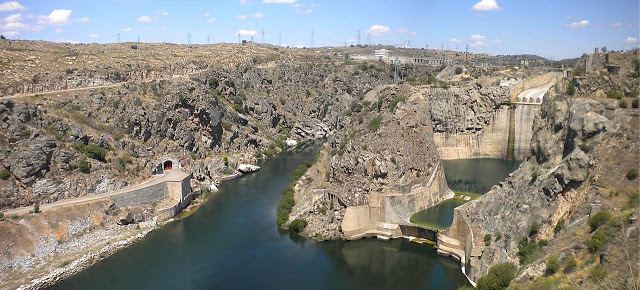
Exceptionally large floods are not necessary to trigger the creation of gorges within hard rocks such as granite, according to a new study involving Plymouth University.
Researchers from Spain and the UK used a combination of archive images and survey data to demonstrate how the diversion of water down an overspill channel from a dam in North West Spain had a profound impact on its surroundings.
It showed there was rapid erosion in the six years following the dam’s construction, with just five flood events creating a new gorge more than 270m long, 160m wide and 100m deep.
While such change might be expected in cases of extremely large flood events (for example glacial lake outburst floods), this case study suggests it can also be caused by small to moderate events, with the structural pattern of the bedrock being the primary control on landscape change.
Scientists believe this study, published in Nature Communications, could advance our understanding about the potential for gorge erosion across the world, but also where similar morphological features have been identified on other planetary bodies such as Mars.
One of the paper’s authors Dr Anne Mather, Associate Professor in Physical Geography at Plymouth University, said:
“If you showed someone images of the gorge, they would probably say the erosion had taken place over a long period with exceptional flooding. To put it into context, the heads of Niagara Falls and Victoria Falls retreat at around 1.2-2m and 0.5m per year (respectively), but here we saw more than 270m over the space of just six years. It demonstrates that the rate of water flow is not always the major contributing factor to gorge erosion.”
Dr Mather and Dr Martin Stokes, from the University’s School of Geography Earth and Environmental Sciences, worked on the study with colleagues from the Universidad Nacional de Educación a Distancia (UNED) and the Universidad Complutense de Madrid.
They analysed archives relating to the Ricobayo dam, which was constructed along the Río Esla in North West Iberia in the 1930s, in an area previously characterised by seasonal floods.
When it was built, the dam included an unlined spillway and – after its completion in 1933 – a series of overtopping floods occurred. Additional flood gates were added in 1938 and only one incidence of further overtopping being recorded in early 1939.
As such, the widening and retreating effects on the gorge can be confined to this period, with the data and images providing an almost unrivalled snapshot of bedrock erosion.
Dr Mather added:
“There are countless instances where erosion is said to have happened over time, but the level of information relating to the Ricobayo means we can paint a very detailed picture of what happened here. As such, this study highlights several key observations concerning the morphological adjustment of bedrock rivers on Earth and Mars. It is a particularly good analogue for what can happen during a naturally occurring river diversion, or any sudden change to a river that creates a nick point in the system, providing us with an insight into how a bedrock river may respond to environmental change.”
Reference:
“Exceptional river gorge formation from unexceptional floods.” Nature Communications 6, Article number: 7963 DOI: 10.1038/ncomms8963
Note: The above post is reprinted from materials provided by University of Plymouth.










